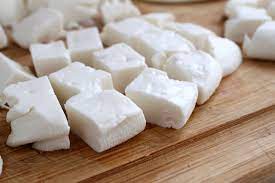Feta cheese is a rewarding and delicious choice, one of the most well-known and easiest-to-make cultured cheddar cheeses. Depending on the cheese culture and your preferences, it can be made firm or crumbly. Feta can be brine-cured, dry-salted or sliced into chunks. You can either leave it in a large block with Kalamata olives and raw red onions or sprinkle it over a large green salad. For a sweet and tangy dessert, you can bake it with honeyed strawberry slices or use the brine to make our favorite martinis.
Because feta is immersed in salty liquids for so long, much of its moisture has been absorbed into the brine. The cheese becomes hard to melt and crumbly. Think of it as an ingredient, or garnish. You can add it to a savory filling for grilled or roasted meats, poultry, and fish; you can also use it in cornbread batter or topping for an orzo salad. Once the feta is firmly pressed when it is made, it can easily be cut into pieces, brushed with olive oils, and then grilled on a kebab.
The saltiness of feta will disappear if it is allowed to dry in the fridge. This will make the cheese more grantable and delicate. Sprinkle some feta powder on hot flatbread with herbs for a casual lunch. This is a wonderful way to enjoy cheese without being too obsessed.
Although feta cheese is a popular choice in Mediterranean cuisines such as Greek and Mediterranean, it has gained attention recently. TikTok’s viral recipe for baked Feta pasta made it the most talked-about cheese. One-pan recipes called for placing a block of feta cheese into a pool of cherry tomato slices drizzled with olive oils. Bake the two until the cheese is soft and creamy and the tomatoes burst with sweet juices. The baked mixture was then topped with cooked pasta. Soon, home cooks all over the world were following the recipe.
A sweet counterpoint is also a good pairing for feta. You can serve it with honey drizzled on grilled stone fruits or figs and topped off with crumbled feta. During warm weather, it can be sliced or broken up and then mixed with tomatoes, basil, and watermelon. If you like heat, add minced jalapeno.
More: Sprinkle your feta with honey-infused thyme.
You don’t need to add salt to feta cheese because it has already been salt-cured. You can rinse the exterior brine off the feta or soak it in cold water if the taste is not right for you. There are many ways to use feta, which can be used for all meals. Let’s now learn how to make homemade Feta cheese.
Note: You can order special cheese-making ingredients and supplies online from The Beverage People. It also has other resources.
Crumbly Feta cheese
This recipe makes one pound of feta. Here are the ingredients:
1 Gallon pasteurized whole milk1/8 teaspoon mild lipstick powder, dissolved into 1/4 cup of cool non-chlorinated liquid 20 minutes before use
1/4 teaspoon mesophilic starter, direct-set (preferably? MM 100 oder MA 011)
1/4 teaspoon liquid calcium chloride, diluted in 1/4 cup cool, unchlorinated tap water
1/2 teaspoon liquid rennet. One cup of cool, nonchlorinated water.
Flaky sea salt, kosher salt, 2 to 4 tablespoons
Ten ounces of kosher salt (preferably Diamond Crystal), dissolved in 1/2 gallon cold, nonchlorinated, water, and chilled to 55°F (optional, for brine).
Heat milk and diluted lipase together in a saucepan until they reach 86degF. Add the starter to the mixture and whisk for two minutes. Keep the milk covered at 86 degrees F. Cover and let it rest for an hour. You can then look through all our favorite feta recipes to decide which one you want to make with your fresh cheese. Stir in the calcium chloride and whisk for a few more minutes. Finally, add the rennet.
Cover the bowl and let it sit at 86°F for 1 hour. Cut the curds into cubes once the curds have cooled and the whey has risen to the surface. Allow cooling for 10 minutes at 86°F.
Use a rubber spatula to stir the curds gently. After 20 minutes, raise the temperature to 90 degrees F. After this time, the curds will be more pillow-like. Allow them to rest for five minutes without any interruptions. They will eventually settle to the bottom.
Line a strainer using dampened butter muslin or cheesecloth. Use a spoon to scoop the curds into your strainer.
To create a draining bag:
- Tie the corners together.
- Slide a wooden spoon handle through it.
- Hang the bag over a large pot or bucket for 10 minutes.
- Transfer the curds to a square cheese mold.
- Salt the surface generously and let them drain.
- Turn the cheese over after an hour.
- Return the mold to the bowl and salt the surface. This will firm up the cheese and improve its texture.
- Cover the molds in cheesecloth and let them drain at room temperature for 8 hours or overnight.
Slice the cheese into 1-inch slices and then again cut into cubes. Salt all surfaces and sprinkle with salt. Cover the bowl with plastic wrap or a lid and let it sit in the salt for five to seven days. To further preserve and enhance saltiness, the cheese can be covered with brine for 21-30 days. If you find the finished cheese too salty, soak it in nonchlorinated hot water for an hour and then drain the cheese before you use it.




